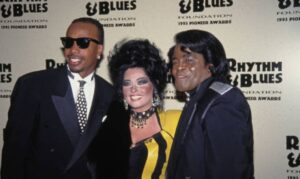Few names in American music history shine brighter than James Brown, the “Godfather of Soul.” From humble beginnings in South Carolina to a global stage that transformed rhythm and blues into funk, his influence transcended genres, race, and generations. Beyond his electric performances, Brown’s personal life — his marriages, children, controversies, and enduring wealth — continue to fascinate fans worldwide.
This detailed article explores every dimension of the man behind the myth: James Brown’s net worth, early life, age, iconic songs, film appearances, relationships, fatherhood, and the story of his third wife Adrienne Rodriguez — providing a holistic view of one of music’s most powerful legends.
Who Is James Brown?
James Joseph Brown was born on May 3, 1933, in Barnwell County, South Carolina, and raised in Augusta, Georgia. He grew up in deep poverty, often hustling for small jobs and singing for coins in the streets. His early life was marked by hardship — his mother, Susie Behlings, left the family when he was a child, and his father, Joseph Gardner Brown, struggled to make ends meet as a laborer.
Brown’s journey from poverty to power epitomizes the American dream. He discovered music while serving a prison sentence for petty theft as a teenager. A fellow inmate noticed his talent and introduced him to gospel groups after his release. By the 1950s, he joined The Famous Flames, launching his professional career and setting the stage for the most explosive soul performer of the 20th century.
Over his five-decade career, James Brown redefined modern music, influencing artists from Michael Jackson and Prince to Bruno Mars and Kendrick Lamar. His musical innovation gave birth to the funk genre and inspired countless hip-hop beats that dominate music even today.
James Brown’s Age and Lifespan
Born in 1933, James Brown lived through an extraordinary 73 years of evolution in music, politics, and culture. He died on December 25, 2006, in Atlanta, Georgia, due to congestive heart failure and pneumonia. Had he lived, he would be 92 years old in 2025.
Even in his seventies, Brown remained a tireless performer, touring and recording up until his death. His work ethic earned him nicknames such as “The Hardest Working Man in Show Business” — a title no one ever dared contest.
James Brown’s Net Worth
When it comes to James Brown’s net worth, reports vary due to the complex legal battles surrounding his estate. According to Celebrity Net Worth, Brown’s wealth at the time of his death was estimated at around $100 million, but court documents and estate filings show figures closer to $5–10 million after taxes and debts.
Much of the confusion stems from his numerous business ventures, real estate holdings, and music royalties. Brown owned partial rights to several of his biggest hits, and his songs continue to generate millions in licensing fees for movies, commercials, and streaming platforms.
The ongoing legal disputes over his estate — particularly regarding the validity of his fourth marriage and the division of royalties among his heirs — have delayed final settlements for years. In 2021, after more than a decade of courtroom battles, the estate reached an agreement reportedly worth tens of millions of dollars, ensuring that Brown’s legacy would continue to fund educational scholarships, as per his will.
Despite the controversies, one thing remains clear: James Brown’s net worth reflects not only his financial success but his cultural impact. His work laid the foundation for modern R&B, funk, and hip-hop, making him one of the most sampled and celebrated artists of all time.
James Brown’s Music and Iconic Songs
James Brown’s discography is nothing short of legendary. His sound evolved from soulful ballads to funk anthems that revolutionized the music industry. Among his most iconic songs are:
- “Papa’s Got a Brand New Bag” (1965) – Considered one of the first funk songs, it showcased Brown’s rhythmic innovation and distinctive vocal phrasing.
- “I Got You (I Feel Good)” – Perhaps his most recognizable hit, this song’s upbeat tempo and brass-driven sound remain timeless.
- “It’s a Man’s Man’s Man’s World” (1966) – A passionate, soulful anthem celebrating women’s role in the world.
- “Cold Sweat” (1967) – Often cited as the blueprint for funk music, emphasizing rhythm over melody.
- “Get Up (I Feel Like Being a) Sex Machine” (1970) – A groove-heavy masterpiece and staple in Brown’s live shows.
- “Say It Loud – I’m Black and I’m Proud” (1968) – A civil rights anthem that empowered African-American pride.
These songs not only topped charts but also became rallying cries for social change. Brown’s signature sound — syncopated rhythms, horn stabs, and call-and-response vocals — created the foundation for funk and heavily influenced hip-hop producers decades later.
In total, Brown released over 50 albums and 119 charting singles, including 17 that reached No. 1 on the R&B charts. His performances were known for their intensity, choreography, and signature cape routine — leaving audiences breathless at every show.
James Brown’s Movies and Film Career
While primarily a musician, James Brown also made several memorable appearances in films and documentaries that captured his charisma and energy.
Film Appearances and Cameos
- “The Blues Brothers” (1980): Brown appeared as Reverend Cleophus James, performing a high-energy gospel scene that became one of the movie’s highlights.
- “Rocky IV” (1985): He performed “Living in America” in one of the most iconic scenes in the film, symbolizing American confidence during the Cold War era.
- “Doctor Detroit” (1983): Another energetic cameo that capitalized on his stage persona.
Biographical Films and Documentaries
The biopic “Get On Up” (2014), starring Chadwick Boseman, captured Brown’s rise to fame, his personal demons, and his musical genius. The film was widely praised for its authenticity and Boseman’s performance, earning the approval of Brown’s family members.
Additionally, several documentaries — such as Mr. Dynamite: The Rise of James Brown (2014, directed by Alex Gibney) — have explored his political activism, music evolution, and controversies, solidifying his role as one of America’s cultural cornerstones.
James Brown’s Relationships and Marriages
James Brown’s personal life was as dynamic as his music career. He was married three times officially, with a fourth marriage disputed in court.
- Velma Warren (1953–1969): Brown’s first wife, with whom he had one child. Their marriage ended in divorce.
- Deidre “Deedee” Jenkins (1970–1981): His second marriage produced two daughters, Yamma Brown and Deanna Brown Thomas.
- Adrienne Rodriguez (1984–1996): Brown’s third wife, who tragically died in 1996. Their relationship was turbulent and marked by several legal issues.
- Tomi Rae Hynie (2001–2006): She claimed to be Brown’s fourth wife and the mother of his youngest son, James Joseph Brown II, but the marriage was legally contested due to her previous, undissolved marriage.
Despite his fame, Brown’s personal life was complicated by legal battles, domestic violence allegations, and disputes over paternity and inheritance. His relationships reflected the same fiery intensity that defined his music — passionate, but often chaotic.
James Brown and Adrienne Rodriguez
One of the most discussed relationships in Brown’s life was his marriage to Adrienne Lois Rodriguez. Born in 1950, Adrienne was a talented hairstylist and singer who married Brown in 1984.
Their relationship was intense but fraught with legal troubles. Adrienne accused Brown of abuse on multiple occasions, and they separated several times before her untimely death in 1996, reportedly due to complications from cosmetic surgery.
Despite their turbulent marriage, Adrienne played a significant role in Brown’s later life, appearing at his side during major public events and supporting his performances. Their relationship remains a central chapter in the story of the man who balanced fame and fury with equal force.
James Brown’s Father and Family Roots
James Brown’s father, Joseph “Joe” Gardner Brown, was a field laborer and occasional bootlegger who raised James under difficult circumstances. His mother, Susie Behlings, left the family when James was around six years old, forcing him to fend for himself in poverty.
These experiences forged Brown’s resilience. Growing up in the Jim Crow South, he developed an indomitable drive to rise above his circumstances. His early life in Augusta, Georgia, shaped his work ethic and deep understanding of rhythm and struggle — both of which became his trademarks as an artist.
James Brown’s Children
James Brown was the father of at least nine children, though various reports suggest more. His confirmed children include:
- Teddy Brown (died 1973 in a car accident)
- Terry Brown
- Larry Brown
- Daryl Brown
- Venisha Brown (died 2018)
- Yamma Brown (daughter with Deidre Jenkins)
- Deanna Brown Thomas (daughter with Deidre Jenkins)
- James Joseph Brown II (son with Tomi Rae Hynie)
Several of his children have continued his legacy in music and philanthropy. Deanna Brown Thomas, for instance, runs the James Brown Family Foundation, promoting education and social change — honoring her father’s vision of helping underprivileged youth.
James Brown’s Legacy
James Brown’s legacy transcends music. His powerful performances, activism, and pride in his African-American identity influenced generations of artists and civil rights advocates.
In 1968, amidst racial tensions across the United States, Brown released “Say It Loud – I’m Black and I’m Proud,” giving voice to a movement and inspiring a generation to embrace empowerment.
He received multiple honors, including:
- Induction into the Rock and Roll Hall of Fame (1986)
- Grammy Lifetime Achievement Award (1992)
- Hollywood Walk of Fame star (1997)
Even today, his voice and dance moves echo in the works of Beyoncé, Bruno Mars, Mick Jagger, and countless others. His energetic style and musical experimentation continue to define what it means to be a performer.
Conclusion: The Godfather Lives On
James Brown was more than a singer — he was a movement. His story of struggle, ambition, and triumph embodies the essence of soul itself. From groundbreaking hits to complex personal relationships, from immense wealth to legal turmoil, Brown’s life remains a vivid testament to the power of reinvention and resilience.
Though he passed away in 2006, the James Brown legacy continues to groove across generations, reminding us that music can change the world — one rhythm at a time.
Article published on londonzine — your source for timeless stories, culture, and legends of music.



